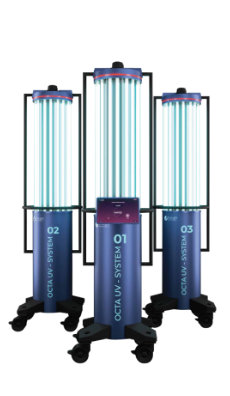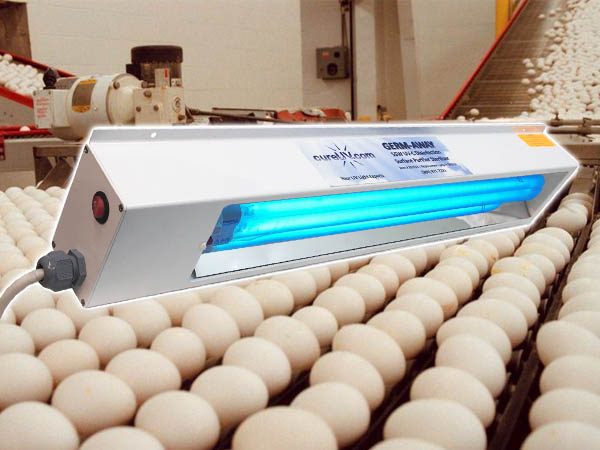Raise Your Cleanliness Requirements with Advanced UV Surface Disinfection Innovation
Raise Your Cleanliness Requirements with Advanced UV Surface Disinfection Innovation
Blog Article
Revealing the Conveniences of UV Disinfection: Ensuring Clean and Disinfected Areas
While traditional cleaning techniques have actually long been relied upon, innovations in innovation have actually presented a cutting-edge solution that ensures tidy and sanitized rooms: UV sanitation. Furthermore, we will dig right into the safety considerations that have to be taken right into account when carrying out UV disinfection. Prepare to uncover a brand-new measurement of cleanliness and find the untapped possibility of UV disinfection.

The Scientific Research Behind UV Sanitation
UV disinfection is a scientifically proven technique that utilizes ultraviolet light to eliminate dangerous microbes from surfaces and water. The science behind UV disinfection lies in the capacity of UV-C light to damage the DNA and RNA of microorganisms, rendering them incapable to recreate and creating their ultimate fatality. UV-C light drops within the wavelength variety of 200 to 280 nanometers, which is extremely effective in damaging bacteria, viruses, and other virus.
When revealed to UV-C light, the hereditary product of bacteria absorbs the power from the light, bring about the formation of thymine dimers. These dimers disrupt the typical duplication and transcription processes of the microbes, inhibiting their capability to survive and reproduce (uv surface disinfection). The DNA and RNA damages triggered by UV-C light is deadly to the microorganisms, making UV sanitation a reputable and efficient method for eliminating a vast array of virus
UV disinfection is especially useful in atmospheres where typical chemical anti-bacterials might be impractical or ineffective. It is a non-chemical method that does not leave any residues or unsafe spin-offs, making it risk-free for use in food processing, medical care facilities, water treatment plants, and numerous other industries. UV sanitation is environmentally friendly, as it does not add to the growth of antibiotic-resistant microorganisms or other hazardous contaminants.
Efficiency of UV Sanitation on Pathogens
The performance of UV sanitation in removing virus has been extensively examined and shown in many clinical research studies. UV radiation has the capacity to inactivate a wide variety of microorganisms, consisting of viruses, microorganisms, and fungi, by harming their DNA or RNA. This stops them from duplicating and triggering infections.
One study published in the American Journal of Infection Control discovered that UV sanitation worked in reducing the existence of numerous drug-resistant bacteria in medical facility areas. Another research carried out by the National Institute for Occupational Safety and security and Wellness demonstrated that UV disinfection had the ability to get rid of 99.9% of the flu infection on surface areas.
UV sanitation has actually likewise revealed assurance in combating the spread of healthcare-associated infections (HAIs) According to a research study published in The Lancet, the usage of UV-C light along with typical cleansing methods considerably minimized the occurrence of HAIs in a hospital setting.
Moreover, UV disinfection has confirmed to be efficient against emerging microorganisms, such as the serious intense breathing disorder coronavirus 2 (SARS-CoV-2), which creates COVID-19. A research conducted by the National Emerging Infectious Conditions Laboratories demonstrated that UV-C light can suspend the infection on surface areas within secs.
Applications of UV Disinfection in Different Setups
With its tested effectiveness in eliminating microorganisms, UV sanitation has actually found applications in a variety of settings. One of one of the most common locations where UV sanitation is utilized is in health care centers. UV technology is used to sanitize patient spaces, operating areas, and various other high-touch surfaces, minimizing the risk of healthcare-associated infections. Furthermore, UV disinfection is additionally being applied in food handling plants and dining establishments to make sure the safety and security of foodstuff and avoid the spread of foodborne ailments. UV sanitation is also useful in water therapy plants, where it is utilized to kill dangerous microbes and you could try these out provide risk-free alcohol consumption water.
An additional vital application of UV disinfection impends filtration market. UV air cleansers are utilized in household, industrial, and industrial settings to get rid of airborne microorganisms, viruses, and mold spores. This technology is specifically beneficial in atmospheres where individuals are a lot more at risk to respiratory system infections, such as medical facilities, schools, and office complex.
Additionally, UV sanitation is progressively being used in public transport systems, such as trains and buses, to maintain clean and sanitized spaces for passengers. UV light is employed to sanitize surfaces and air inside the vehicles, decreasing the danger of spreading infectious illness.
Benefits of UV Sanitation Over Standard Approaches
In contrast to traditional methods, UV disinfection uses a variety of unique benefits that make it a preferable option in numerous industries and settings. One considerable advantage is its performance against a wide selection of microbes, consisting of fungis, microorganisms, and infections. Unlike chemical disinfectants that may have limited effectiveness against particular virus, UV disinfection is a non-selective process that can eliminate or suspend a wide spectrum of hazardous organisms.
One more benefit of UV disinfection is its capability to supply rapid and effective sanitation. Typical disinfection techniques often need longer contact times or multiple steps to accomplish the preferred degree of disinfection. In comparison, UV light can provide prompt and constant disinfection, reducing downtime and raising performance in numerous applications.
UV disinfection likewise offers a eco pleasant and secure option to standard disinfection techniques. uv surface disinfection. Unlike chemical representatives, UV light does not leave any unsafe residues or byproducts, making it ideal for use in delicate settings such as food processing centers, medical care settings, and water treatment plants
Furthermore, UV disinfection is a cost-effective service over time. While the upfront investment for UV sanitation systems might be higher than conventional approaches, the operational prices are commonly reduced. UV lights have a lengthy life-span and call for very little upkeep, leading to minimized labor and replacement expenses.
Security Considerations for UV Sanitation
Considering the prospective risks associated with UV disinfection, it is essential to deal with the safety and security factors to consider associated with implementing this innovation. UV disinfection utilizes ultraviolet light to kill or inactivate bacteria, making it an efficient method for sanitizing numerous surface areas and things. It is vital to recognize that UV radiation can additionally posture risks to human wellness if correct safety steps are not complied with.
Primarily, direct exposure to UV radiation can trigger damage to the skin and eyes. Long term direct exposure can cause sunburn, skin damage, and even an increased danger of establishing skin cancer. As a result, it is important to make certain that UV sanitation systems are effectively enclosed and furnished with security features such as automated shut-off devices or movement sensors to avoid unintentional exposure.

Furthermore, correct training and education are important for those in charge of operating UV disinfection systems. They need to understand the potential hazards, recognize the safety methods, and know exactly how to take care of and keep the equipment correctly.
Final Thought
To conclude, UV sanitation provides countless benefits in guaranteeing tidy and disinfected spaces. Its performance in eliminating virus find out this here has been shown via clinical research. UV you can try these out sanitation can be applied in different setups, consisting of medical care centers, food processing plants, and water treatment systems. Compared to traditional techniques, UV disinfection has benefits such as faster disinfection times, minimal chemical usage, and no hazardous byproducts. Security factors to consider need to be thought about to stop possible dangers related to UV direct exposure.
UV sanitation is a medically proven technique that utilizes ultraviolet light to eliminate dangerous microorganisms from surface areas and water. The DNA and RNA damages triggered by UV-C light is deadly to the bacteria, making UV sanitation a trusted and effective approach for eliminating a broad variety of microorganisms.
An additional benefit of UV sanitation is its capability to give efficient and rapid disinfection. UV sanitation utilizes ultraviolet light to kill or suspend bacteria, making it an efficient approach for sterilizing various surface areas and objects. Compared to conventional approaches, UV sanitation has benefits such as faster disinfection times, very little chemical use, and no dangerous by-products.
Report this page